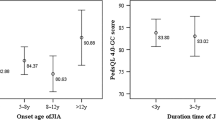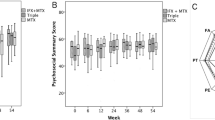Abstract
This study aimed to investigate the proxy-reported Health related quality of life (HRQOL) and its determinants in patients with juvenile idiopathic arthritis (JIA). It was hypothesized that HRQOL would decrease with worsening disease and disability. Data were available in cross-sectional study on children and adolescents with JIA according to the ILAR criteria. Patient demographics, type of JIA, clinical determinants and laboratory parameters relating to JIA were obtained for each patient. Functional disability was assessed using the parent’s or children’s version of the child health assessment questionnaire (CHAQ). The HRQOL was evaluated using the juvenile arthritis quality of life questionnaire (JAQQ). These questionnaires were previously translated and validated in Moroccan children. A total of 80 participants were enrolled with mean age of 11 [6–17 years], and female predominance (59%). Many patients (42.5%) had oligoarticular subtype; 31.3% polyarticular subtypes and 26.2% systemic form. The mean global score of JAQQ was 2.6 ± 1.3 (1–6). Patients with persistant oligoarticular had better gross motor function (P < 0.0001), better fine motor function (P < 0.0001), less psychosocial impact (P = 0.001), and less symptoms (P = 0.001) in comparison with polyarticular and systemic subtypes. The HRQOL assessed by the JAQQ was worse in adolescent patients in comparison with children except for symptoms (P = 0.15). The gender (P = 0.95), age at onset of JIA (P = 0.81), and evolution duration (P = 0.34) were not correlated with global score of JAQQ. The diagnosis delay was significantly associated with decrease of HRQOL (P = 0.001). The decrease of HRQOL was correlated with disease activity [pain (VAS), painful and swollen joints, erythrocyte sedimentation rate (for P < 0.0001)], with disability index (CHAQ) (P = 0.001) and presence of hip involvement (P = 0.01). This study suggests that JIA can have a significant adverse effect on the HRQOL of moroccan patients, particularly adolescents with polyarticular and systemic subtypes. Disease duration, disability score (CHAQ) and pain were the strongest determinants of poorer HRQOL.

Similar content being viewed by others
References
Gare BA, Fasth A (1995) The natural history of juvenile chronic arthritis: a population based cohort study.II.Outcome. J Rheumatol 22:308–319
Foster HE, Marshal N, Mayers A, Dunkley P (2003) Outcome in adults with juvenile idiopathic arthritis- a quality of life study. Arthritis Rheum 48:767–775. doi:10.1002/art.10863
Ruperto N, Buratti S (2004) Duarte-Salazar. Health-related quality of life in Juvenile-onset systemic lupus erythematosus and its relationship to disease activity and damage. Arthritis Rheum 51:458–464. doi:10.1002/art.20412
Flato B, Lien GH, Smerdel A (2003) Prognosis factors in juvenile rheumatoid arthritis: a case control study revealing early predictors and outcome after 14.9 years. J Rheumatol 30:386–393
Brunner HI, Giannini E (2003) Health-related quality of life in children with rheumatic diseases. Curr Opin Rheumatol 15:602–612. doi:10.1097/00002281-200309000-00014
Jordan JM (1999) Effect of race and ethnicity on outcomes in arthritis and rheumatic conditions. Curr Opin Rheumatol 11:98–103. doi:10.1097/00002281-199903000-00003
Burgos-Vargas R (1999) Assessment of quality of life in children with rheumatics’ disease. J Rheumatol 26:1432–1435
Gutierrez-Suarez R, Pistorio A, Cespedes Cruz A (2007) Health-related quality of life of patients with juvenile idiopathic arthritis coming from 3 different geographic areas. The PRINTO multinational quality of life cohort study. Rheumatol 46:314–320. doi:10.1093/rheumatology/kel218
Petty RE, Southwood TR, Baum J (1998) Revision of the proposed classification for juvenile idiopathic arthritis: Duraban, 1997. J Rheumatol 25:1991–1994
Duffy CM, Arsenault L, Duffy KN (1997) The juvenile arthritis quality of life questionnaire: development of a new responsive index for juvenile rheumatoid arthritis and juvenile spondyloarthritides. J Rheumatol 24:738–746
Jolles BM, Buchbinder R, Beaton DB (2005) A study compared patient-specific indices for musculaoskeletal disorders. J Clin Epid 58:791–801. doi:10.1016/j.jclinepi.2005.01.012
Singh G, Athereya B, Fries JF (1994) Measurement of health status in children with juvenile rheumatoid arthritis. Arthritis Rheum 37:1761–1769. doi:10.1002/art.1780371209
Brasil TB, Ferriani PL, Machado CSM (2003) Health-related quality of life survey about children and adolescents with juvenile idiopathic arthritis. J Pediatr (Rio J) 79(1):63–68. doi:10.1590/S0021-75572003000100011
Janse AJ, Sinnema G (2005) Uiterwaal, Kimpen. Quality of life in chronic illness: peceptions of parents and pediatricians. Arch Dis Child 90:486–491. doi:10.1136/adc.2004.051722
Cassidy JT, Levinson JE, Bass JC (1986) A study of classification criteria for a diagnosis of juvenile rheumatoid arthritis. Arthritis Rheum 29:274–281. doi:10.1002/art.1780290216
McDonagh JE, Southwood TR, Shaw KL (2007) The impact of a coordinated transitional care programme on adolescents with juvenile idiopathic arthritis. Rheumatol 46:161–168. doi:10.1093/rheumatology/kel198
Show KI, Southwood TR, Duffy CM, McDonagh JE (2006) Health-related quality of life in adolescents with juvenile idiopathic arthritis. Arthritis Rheum 55(2):199–207. doi:10.1002/art.21852
Shaw KL, Southwood TR, McDonagh JE (2005) British Society of Paediatric and Adolescent Rheumatology. Growing up and moving on in rheumatology: transitional care and quality of life in a multicentre cohort of adolescents with juvenile idiopathic arthritis (JIA). Rheumatology (Oxford) 44(Suppl 1):92. doi:10.1093/rheumatology/keh603 abstract
Blum RW, Garell D, Hodgman CH, Jorissen TW, Okinow NA, Orr DP et al (1993) Transition from child-centered to adult health-care systems for adolescents with chronic conditions: a position paper of the Society for Adolescent Medicine. J Adolesc Health 14:570–576. doi:10.1016/1054-139X(93)90143-D
Sawer MG, Whitham JN, Roberton DM (2004) The relationship between health-remated quality of life, pain and coping strategies in juvenile idiopathic arthritis. Rheumatol 43:325–330. doi:10.1093/rheumatology/keh030
Author information
Authors and Affiliations
Corresponding author
Rights and permissions
About this article
Cite this article
Amine, B., Rostom, S., Benbouazza, K. et al. Health related quality of life survey about children and adolescents with juvenile idiopathic arthritis. Rheumatol Int 29, 275–279 (2009). https://doi.org/10.1007/s00296-008-0672-y
Received:
Accepted:
Published:
Issue Date:
DOI: https://doi.org/10.1007/s00296-008-0672-y




